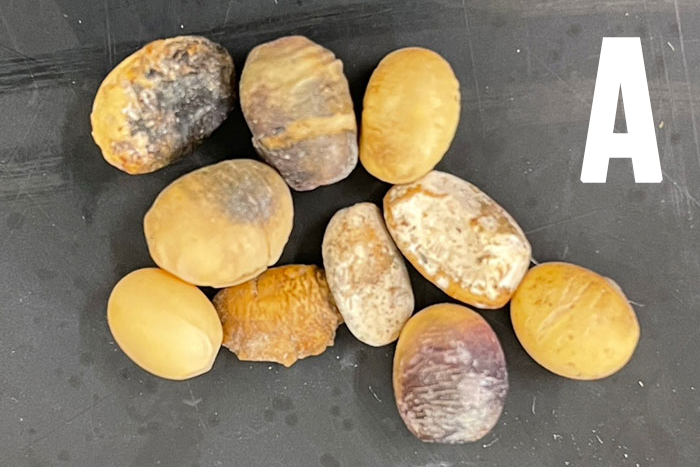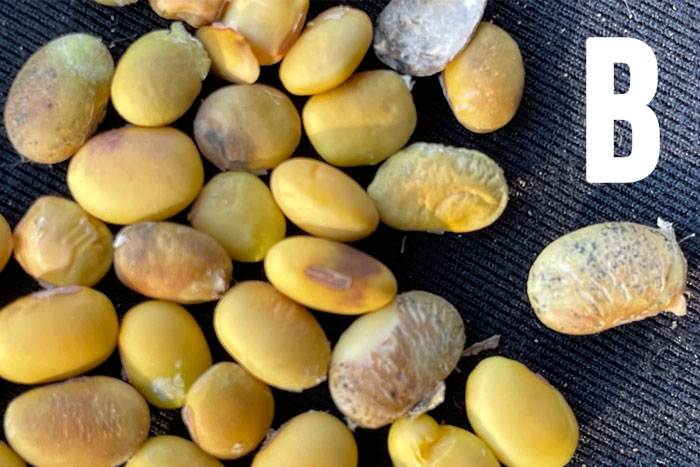Columbia, Missouri, USA
October 29, 2024
The 2024 soybean growing season finished with significant quality issues in southeast Missouri. Farmers are being heavily docked at the elevator, further aggravating the already low commodity prices. Problems began after Hurricane Helene brought heavy rainfall to the region in late September, exposing mature beans to excessive moisture.
The wet weather compounded an already difficult growing season in southern Missouri following abnormally dry weather from August to September. Across multiple counties, the late-season water deficit exceeded 6 inches, placing many of them in a moderate to severe drought status, according to the US Drought Monitor System.
Even before Hurricane Helene struck, low test weights were anticipated due to the drought during the soybean seed filling, as predicted by the University of Missouri's Soybean Growth and Yield tool. However, seed deterioration and other quality issues only became apparent after the storm.
Farmers initially observed seed sprouting in the pods as the first sign of damage. As moisture receded, small, deformed seeds with brown to greyish discoloration were left behind (Figure 1). While shattering is common, the damage extends beyond open pods. Farmers also report easily peeled seed hulls and cracks in pod walls (Figure 2). Additionally, plants retained green stems and leaves long after pods reaching harvest maturity. Multiple observations and reports suggest the issue appeared indiscriminate of cultivar, maturity group, or seed brands.
 Figure 1 Brown, deformed seeds were observed once moisture receded. (Image by Blake Barlow, Missouri Soybean Merchandising Council)
Figure 1 Brown, deformed seeds were observed once moisture receded. (Image by Blake Barlow, Missouri Soybean Merchandising Council)
 Figure 2 Tiny slits or openings were observed in pods once moisture receded. Image of soybean pod magnified by microscope.
Figure 2 Tiny slits or openings were observed in pods once moisture receded. Image of soybean pod magnified by microscope.
Mature seeds exposed to standing water absorbed moisture and swelled. Since the seeds were undersized due to drought conditions, this swelling likely caused the hulls to rupture. Once damaged, the seeds became more vulnerable to rapid cycles of wetting and drying, leaving the cotyledons exposed to weather-related deterioration and opportunistic microorganisms. Soybean seed had symptoms and signs of purple seed stain, Diaporthe seed decay, dehydration along with additional symptoms (Figure 3). Further testing of the seed concluded that Fusarium, Cercospora, and Diaporthe species were present in damaged seed samples.

 Figure 3 Symptomatic seed from southeast (A) and southwest Missouri (B). Symptoms included purple seed stain, dehydration, and signs of Diaporthe and Fusarium infections. Pathogens were confirmed by the plant diagnostic clinic.
Figure 3 Symptomatic seed from southeast (A) and southwest Missouri (B). Symptoms included purple seed stain, dehydration, and signs of Diaporthe and Fusarium infections. Pathogens were confirmed by the plant diagnostic clinic.
The United Soybean Board, with support from the Missouri Merchandise Council, has approved a multi-state collaborative project led by Ohio State University to investigate management strategies for mitigating damage. More research is still needed to understand the specific factors contributing to the rapid decline in seed quality, as well as the phytopathogens responsible for this deterioration. Although multiple pathogens were identified, it is unclear which pathogen or pathogens are primarily responsible for the damage and when exactly infection occurred. The slits or cracks in the pods could be opportunity for some pathogens to enter.
Please consider submitting questionable soybean samples to the MU Plant Diagnostic Clinic. This will provide you information and allow us to understand the extent of the situation in 2024.